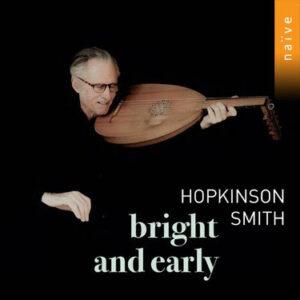Program: #23-07 Air Date: Feb 13, 2023
To listen to this show, you must first LOG IN. If you have already logged in, but you are still seeing this message, please SUBSCRIBE or UPGRADE your subscriber level today.
The brilliant lute performer and teacher Hopkinson Smith joins us (for the first time in some 40 years!) with his latest project, dedicated to Francesco Spinacino and Joan Ambrosio Dalza.
NOTE: All of the music on this program comes from recording bright and early featuring our guest, Hopkinson Smith. It is in the Naive label and is CD E 7545.
The “supreme poet of the lute” (Gramophone), Hopkinson Smith creates a subtle, intimate dialogue between Dalza and Spinacino, witnesses of the instrument’s flourishing culture in Italy at the dawn of the 16th Century.
Hopkinson Smith, that indefatigable pioneer for over forty years, eager hunter of the most distant scores and defender of restoring often obscure manuscripts, will stop at nothing in his exploration and revival of the huge repertoire of his instrument. In this recording, his art, underpinned by a vast historic knowledge together with a profound faith in intuition, examines the first music printed for the lute, and some of the first sources for the instrument to have reached us.
In a perfectly symmetrical programme structured around a central piece by Marchetto Cara, the Swiss American lutenist intertwines pieces inspired from popular dance by Joan Ambrosio Dalza and several free form ricercari by Francesco Spinacino, taken from collections of tablatures published in Venice in 1507 and 1508.
“Some critics may see my reconstruction of the music as heresy, but I considered it necessary, given the degree of confusion in which many of Spinacino’s works have reached us,” warns Hopkinson Smith. “I believed we had to either abandon the originals to their fate, never to be played, or tighten the loose threads of a convincing tapestry as a work of art.”
He weaves this subtle polyphony on a six-course lute built in the tradition of the late 15th Century, giving it heightened resonance and clarity of sound. Inspired by the mystery of these mysterious treasures evoking the distant times and reverie of the Middle Ages, Hopkinson Smith approaches these works with the humility of one who appreciates the incredible richness, and the expressive power of this solitary lutenist who has become a storyteller through his instrument.
From Early Music America: Hopkinson Smith aims to capture the feeling of the “lone lute player who becomes a teller of tales through his instrument” in these reconstructed works by Dalza and Spinacino, utilizing a 6-course lute strung in the tradition of the late 15th century.
Smith focuses on several of Spinacino’s freeform Recercari, printed by Ottaviano Petrucci. Smith writes, “[Petrucci] was the first printer of polyphonic music, and starting in 1501, he produced luxurious editions of major works in beautiful detail with hardly a mistake. Petrucci’s 26th and 27th publications, Spinacino’s Libro Primo and Libro Secondo, both of 1507, on the other hand, are partly a mess. Although the graphic aspect of these publications falls into line with Petrucci’s first prints, the content is another story. There are numerous misprints, non-sequiturs in the texts, missing measures, inexplicable turns of phrase, and moments of bizarre counterpoint.”
“Dalza is more the café and tavern lutenist,” continues Smith. “He opens his book with a biographical detail that he was born in Milan (all we know about his life), and he adds an interesting comment that the pieces presented are somewhat simplified and that he will later publish ‘somewhat more challenging and demanding versions to satisfy those who are skilled in these matters’. (We have no trace of any second book!) I have occasionally felt free to elaborate on some of his texts in a spirit that seems to grow out of his printed versions.”
One other addition to the album that comes neither from the books of Dalza or Spinacino is Marchetto Cara’s intabulation of Io non compro più Speranza, which Smith calls, “one of the most beguiling of frottole, a genre that Petrucci published almost non-stop.”
Hopkinson Smith draws a comparison between reconstructing these works and the restoration of Michelangelo’s Sistine Chapel in the 1980-90s, writing “when the artist’s original colors were once again revealed” they were found to be “bold, clear and bright.”
Joan Ambrosio Dalza ?-1508
- Saltarello ala Ferrarese
Francesco Spinacino ?-c.1507
- Recercare 6
- Recercare 13
Joan Ambrosio Dalza
- Piva ala ferrarese
- Caldibi castigliano
- Caldibi saltarello*
Francesco Spinacino
- Recercare 23
- Recercare 4
Joan Ambrosio Dalza
- Pavana ala ferrarese
Marchetto Cara 1470-c.1525
- Io non compro più Speranza
Joan Ambrosio Dalza
- Poi che volse la mia stella
Francesco Spinacino
- Recercare 25
- Recercare 15
Joan Ambrosio Dalza
- Pavana ala venetiana
- Saltarello ala venetiana
- Piva ala venetiana
Francesco Spinacino
- Recercare 12
- Recercare 19
Joan Ambrosio Dalza
- Poi che’l ciel contrario adverso
- Calata ala spagnola ditto terzetti di zuan Ambroso Dalza
- Tastar de corde
*Reconstruction by Hopkinson Smith
Excerpts from Joan Ambrosio Dalza, Intabulatura de lauto, libro IV (Venise, 1508) | Francesco Spinacino, Intabolatura de lauto, libro I & II (Venise, 1507) | Marchetto Cara, Franciscus bossinensis, libro I (Venise, 1509)
Composer Info
Joan Ambrosio Dalza ?-1508, Francesco Spinacino ?-c.1507, Marchetto Cara 1470-c.1525
CD Info
Naive label CD E 7545
